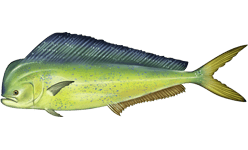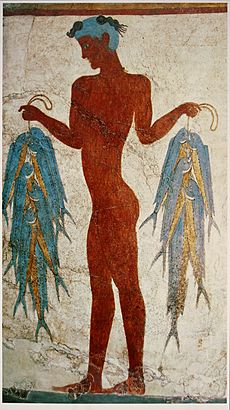Mahi-mahi facts for kids
Quick facts for kids Mahi-mahi |
|
|---|---|
 |
|
| Conservation status | |
| Scientific classification | |
| Synonyms | |
|
The mahi-mahi (Coryphaena hippurus), also known as the common dolphinfish, is a fast-swimming fish that lives near the ocean surface. You can find it in warm waters all over the world, including tropical and subtropical areas. People also call it dorado or simply dolphin, but it's important to remember that it's a fish, not a dolphin mammal! It's one of two types of dolphinfish in the Coryphaenidae family. These fish are often seen in places like the Gulf of Mexico, Costa Rica, Hawaii, and the Indian Ocean.

Contents
What's in a Name?
The name "mahi-mahi" comes from the Hawaiian language. It means "very strong," and it's repeated twice to emphasize how strong these fish are. Even though it's sometimes called "dolphinfish," this can be confusing because it's not related to the dolphin mammals we know. The word "dolphin" in "dolphinfish" likely comes from an old Greek word related to its shape or movement.
In some parts of the Pacific and South Africa, people call the mahi-mahi by its Spanish name, dorado. This means "golden" because of its bright, shiny colors. On the island of Malta in the Mediterranean Sea, it's known as the lampuka.
The famous scientist Carl Linnaeus gave the mahi-mahi its scientific name, Coryphaena, in 1758. This name comes from a Greek word meaning "top" or "apex," possibly referring to the fish's prominent forehead.
About Mahi-Mahi
Appearance
Mahi-mahi have flat bodies and a long fin on their back that stretches almost from their head to their tail. Adult males have a very noticeable forehead that sticks out above their body, while females have a more rounded head. Their tail fins are deeply curved.
These fish are known for their amazing, bright colors. They are golden on their sides and have bright blues and greens on their back and other parts of their body. Their fins can even look iridescent blue. When a mahi-mahi is taken out of the water, its colors often change quickly, going through many different shades before fading to a dull yellow-grey when it dies. This color change is why it's called "dorado" (golden) in Spanish.
Life and Growth
Mahi-mahi usually live for about four years, though some can live up to five. Females are generally smaller than males. Most mahi-mahi caught by fishermen weigh between 7 to 13 kilograms (15 to 29 pounds) and are about a meter (3 feet) long. It's rare to catch one over 15 kg (33 lb), and anything over 18 kg (40 lb) is very unusual.
These fish are among the fastest-growing fish in the ocean. They can swim incredibly fast, up to 92.6 kilometers per hour (57.5 miles per hour)!
Diet and Reproduction
Mahi-mahi are carnivores, meaning they eat other animals. Their diet includes flying fish, crabs, squid, mackerel, and other small fish. They have also been known to eat tiny sea creatures called zooplankton.
Both male and female mahi-mahi become ready to reproduce in their first year, usually when they are about 4 to 5 months old. They can start spawning (laying eggs) when they are only about 20 centimeters (8 inches) long. Females can lay eggs two or three times a year, producing a huge number of eggs—between 80,000 and 1,000,000 each time! In warm waters around 28°C (83°F), mahi-mahi babies can be found all year round, with more appearing in spring and fall.
Mahi-mahi are mostly found near the surface of the water. Their meat is grey-white when raw, but it cooks to a nice white color with a clean, mild taste.
Fishing for Mahi-Mahi
Sport Fishing
Mahi-mahi are very popular for sport fishing. Fishermen love them because they are beautiful, grow to a good size, taste great, and there are usually plenty of them. You can find mahi-mahi in many places, including the Caribbean Sea, the coasts of North and South America, the Gulf of Mexico, the Atlantic Ocean near Florida, the Indian Ocean, and around Hawaii.
When sport fishing, people often look for floating things in the ocean, like wood or clumps of Sargassum (a type of seaweed). Mahi-mahi often gather around these floating objects, which provide shelter and food. Fishermen also look for frigatebirds flying nearby, as these birds often follow schools of fish.
Fishermen use strong fishing gear when trying to catch mahi-mahi. They might use a technique called "bait-and-switch" where they throw small fish or special lures into the water to get the mahi-mahi excited. Then, they cast their line with a hook. Once hooked, mahi-mahi are known for being fast, flashy, and jumping out of the water, making them exciting to catch.
Commercial Fishing
Mahi-mahi is a popular food fish in many countries. The United States and Caribbean countries eat a lot of it, and its popularity is growing in Europe and Australia. Japan and Hawaii are also big consumers.
In the past, mahi-mahi were often caught by accident when fishermen were trying to catch tuna or swordfish. But now, commercial fishermen specifically target mahi-mahi because they are so popular.
In places like French Polynesia, fishermen use harpoons to catch mahi-mahi. They use special fast boats called poti marara because mahi-mahi don't usually dive deep into the water. This harpooning method is also used by fishermen in the Philippines.
Safety and the Environment
When it comes to eating mahi-mahi, there are a few things to know about its safety and how it affects the environment.
Organizations like the Monterey Bay Aquarium and the Environmental Defense Fund (EDF) rate fish based on how sustainably they are caught. For example, mahi-mahi caught in the US Atlantic are often considered a "best choice" because of how they are fished. However, mahi-mahi caught using long lines (a fishing method with very long lines and many hooks) are sometimes rated lower. This is because long lines can accidentally catch other animals like seabirds, sea turtles, and sharks, which is called "bycatch."
The Natural Resources Defense Council suggests how much mahi-mahi you should eat because it can have a moderate amount of mercury. They recommend eating six servings or less per month.
Mahi-mahi can also sometimes carry a natural toxin that causes ciguatera poisoning. This poisoning happens when toxins, produced by tiny algae, build up in the fish's flesh over time. If people eat fish with too much of these toxins, they can get sick. This is a natural process and not caused by pollution.
Images for kids
-
Mahi-mahi are attracted to Sargassum, a type of floating brown algae. It provides them with both a hiding place and food. These lines of Sargassum can stretch for miles across the ocean surface.
-
Grilled mahi-mahi, ready to eat.
See also
 In Spanish: Lampuga para niños
In Spanish: Lampuga para niños







